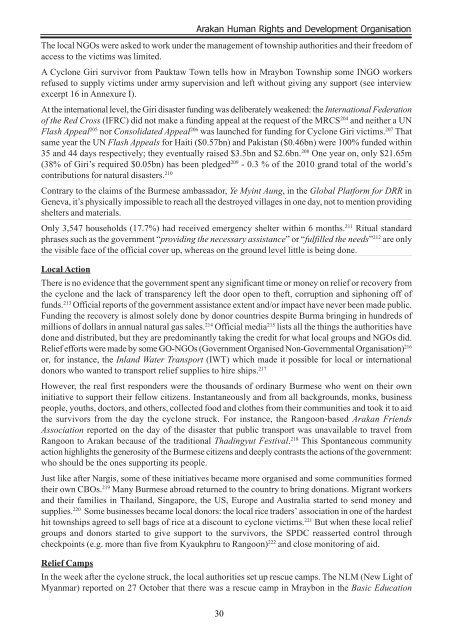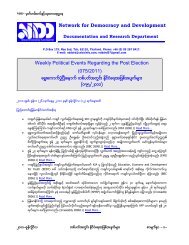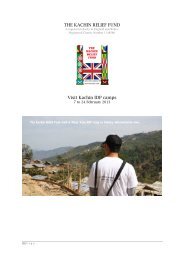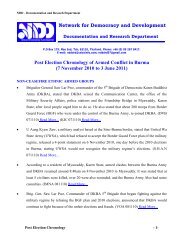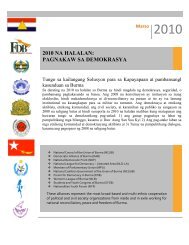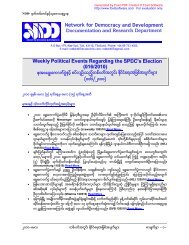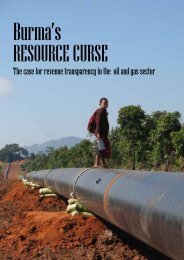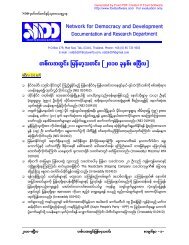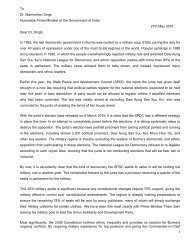Cyclone Giri - Two Years On - Burma Action Ireland
Cyclone Giri - Two Years On - Burma Action Ireland
Cyclone Giri - Two Years On - Burma Action Ireland
You also want an ePaper? Increase the reach of your titles
YUMPU automatically turns print PDFs into web optimized ePapers that Google loves.
Arakan Human Rights and Development Organisation<br />
The local NGOs were asked to work under the management of township authorities and their freedom of<br />
access to the victims was limited.<br />
A <strong>Cyclone</strong> <strong>Giri</strong> survivor from Pauktaw Town tells how in Mraybon Township some INGO workers<br />
refused to supply victims under army supervision and left without giving any support (see interview<br />
excerpt 16 in Annexure I).<br />
At the international level, the <strong>Giri</strong> disaster funding was deliberately weakened: the International Federation<br />
of the Red Cross (IFRC) did not make a funding appeal at the request of the MRCS 204 and neither a UN<br />
Flash Appeal 205 nor Consolidated Appeal 206 was launched for funding for <strong>Cyclone</strong> <strong>Giri</strong> victims. 207 That<br />
same year the UN Flash Appeals for Haiti ($0.57bn) and Pakistan ($0.46bn) were 100% funded within<br />
35 and 44 days respectively; they eventually raised $3.5bn and $2.6bn. 208 <strong>On</strong>e year on, only $21.65m<br />
(38% of <strong>Giri</strong>’s required $0.05bn) has been pledged 209 - 0.3 % of the 2010 grand total of the world’s<br />
contributions for natural disasters. 210<br />
Contrary to the claims of the Burmese ambassador, Ye Myint Aung, in the Global Platform for DRR in<br />
Geneva, it’s physically impossible to reach all the destroyed villages in one day, not to mention providing<br />
shelters and materials.<br />
<strong>On</strong>ly 3,547 households (17.7%) had received emergency shelter within 6 months. 211 Ritual standard<br />
phrases such as the government “providing the necessary assistance” or “fulfilled the needs” 212 are only<br />
the visible face of the official cover up, whereas on the ground level little is being done.<br />
Local <strong>Action</strong><br />
There is no evidence that the government spent any significant time or money on relief or recovery from<br />
the cyclone and the lack of transparency left the door open to theft, corruption and siphoning off of<br />
funds. 213 Official reports of the government assistance extent and/or impact have never been made public.<br />
Funding the recovery is almost solely done by donor countries despite <strong>Burma</strong> bringing in hundreds of<br />
millions of dollars in annual natural gas sales. 214 Official media 215 lists all the things the authorities have<br />
done and distributed, but they are predominantly taking the credit for what local groups and NGOs did.<br />
Relief efforts were made by some GO-NGOs (Government Organised Non-Governmental Organisation) 216<br />
or, for instance, the Inland Water Transport (IWT) which made it possible for local or international<br />
donors who wanted to transport relief supplies to hire ships. 217<br />
However, the real first responders were the thousands of ordinary Burmese who went on their own<br />
initiative to support their fellow citizens. Instantaneously and from all backgrounds, monks, business<br />
people, youths, doctors, and others, collected food and clothes from their communities and took it to aid<br />
the survivors from the day the cyclone struck. For instance, the Rangoon-based Arakan Friends<br />
Association reported on the day of the disaster that public transport was unavailable to travel from<br />
Rangoon to Arakan because of the traditional Thadingyut Festival. 218 This Spontaneous community<br />
action highlights the generosity of the Burmese citizens and deeply contrasts the actions of the government:<br />
who should be the ones supporting its people.<br />
Just like after Nargis, some of these initiatives became more organised and some communities formed<br />
their own CBOs. 219 Many Burmese abroad returned to the country to bring donations. Migrant workers<br />
and their families in Thailand, Singapore, the US, Europe and Australia started to send money and<br />
supplies. 220 Some businesses became local donors: the local rice traders’ association in one of the hardest<br />
hit townships agreed to sell bags of rice at a discount to cyclone victims. 221 But when these local relief<br />
groups and donors started to give support to the survivors, the SPDC reasserted control through<br />
checkpoints (e.g. more than five from Kyaukphru to Rangoon) 222 and close monitoring of aid.<br />
Relief Camps<br />
In the week after the cyclone struck, the local authorities set up rescue camps. The NLM (New Light of<br />
Myanmar) reported on 27 October that there was a rescue camp in Mraybon in the Basic Education<br />
30


